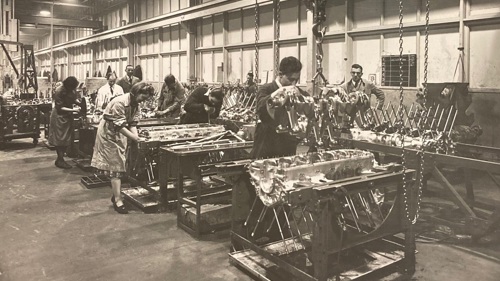Rolls-Royce, Hillington - Times Past

In partnership with the Glasgow Times, our archivists are exploring Glasgow's fascinating history. This week, Barbara McLean writes about Rolls-Royce, Hillington.
Years ago, when I gazed up at the Spitfire suspended in Kelvingrove Museum and Art Gallery during a visit, I little suspected the Glasgow connection to these fighter planes and their equally iconic counterparts, the Lancaster Bombers.
That connection began in the mid-1930s, with war on the distant horizon. It was known that aerial warfare, seen on a much smaller scale during the First World War, would dominate the coming conflict. The United Kingdom required the production of planes on a massive scale. They were needed to defend homes and key targets under attack; to undertake bombing raids of their own and to engage in direct battles with enemy aircraft. Yet, at that time, the industry was not yet developed enough to provide the quantities needed.
A plan was developed to use the established motor industry’s skills, knowledge and technology to create the required output. Preparations were soon underway to set up a network of shadow factories in strategic locations to undertake this work. The Rolls-Royce facility at Hillington (RR Hillington) was one such factory. The original Rolls-Royce facility was at Derby and the decision to site the new shadow factory in Scotland was insurance against the loss of the original plant. Hillington itself was chosen not only for its vicinity to Glasgow but for the skilled local engineering workforce resident within it.
Construction on the factory began on farmland in August 1939 and continued until May 1940 when it was ready to operate. Located over 150 acres, it employed around 25,000 workers, some of whom resided in housing provided by the factory itself. Many also stayed in the nearby estate of Penilee. RR Hillington was a massive operation, and its aim was to produce and repair Merlin engines for aircraft including Spitfires and Lancaster Bombers.
The City Archives holds a photograph album which chronicles the construction and operation of the factory as well as the training of its workforce. Within its beautifully presented pages are images like the one pictured. They capture the start of the factory’s immense contribution to the war effort. Men and women alike are glimpsed with their heads bent over engines in mid-assembly, just several of the thousands which were produced during the war.
Such was RR Hillington’s importance to the war effort that it was photographed during the Luftwaffe’s aerial reconnaissance of Scotland. These photographs were used to select bombing targets and the factory was one of the original targets of the German bombing raids of 13 and 14 March 1941. While the factory escaped destruction, other areas of Clydeside were not so lucky. These were the raids which devasted parts of Clydeside, notably the burgh of Clydebank and Kilmun Street in Maryhill.
RR Hillington survived the war years to become a major local employer and a focal point of local community life. Many met their future husband or wife on the factory floor and it wasn’t uncommon for generations of the same family to serve their time as apprentices there. Its closure in 2005, when production moved to Inchinnan, was keenly felt.
